Information Security Report: Voter Records Breach and WannaCry Attacks
VerifiedAdded on 2020/02/24
|10
|2492
|149
Report
AI Summary
This report provides a comprehensive analysis of two significant information security incidents: the voter records breach and the WannaCry ransomware attack. The voter records breach involved the exposure of over 198 million voter records due to misconfigured online services, highlighting the negligence of the data analytics company, Deep Root, and the lack of basic security measures. The report details the problem, how the attack occurred, and proposes solutions such as risk assessments, encryption, and access control procedures. The second part of the report focuses on the WannaCry attack, a global ransomware incident that exploited vulnerabilities in Windows systems. It describes the problem, the affected parties, the method of attack utilizing the EternalBlue vulnerability, and preventative measures like firewall implementation and port control. The report emphasizes the importance of proactive security measures and risk assessments to mitigate such threats.
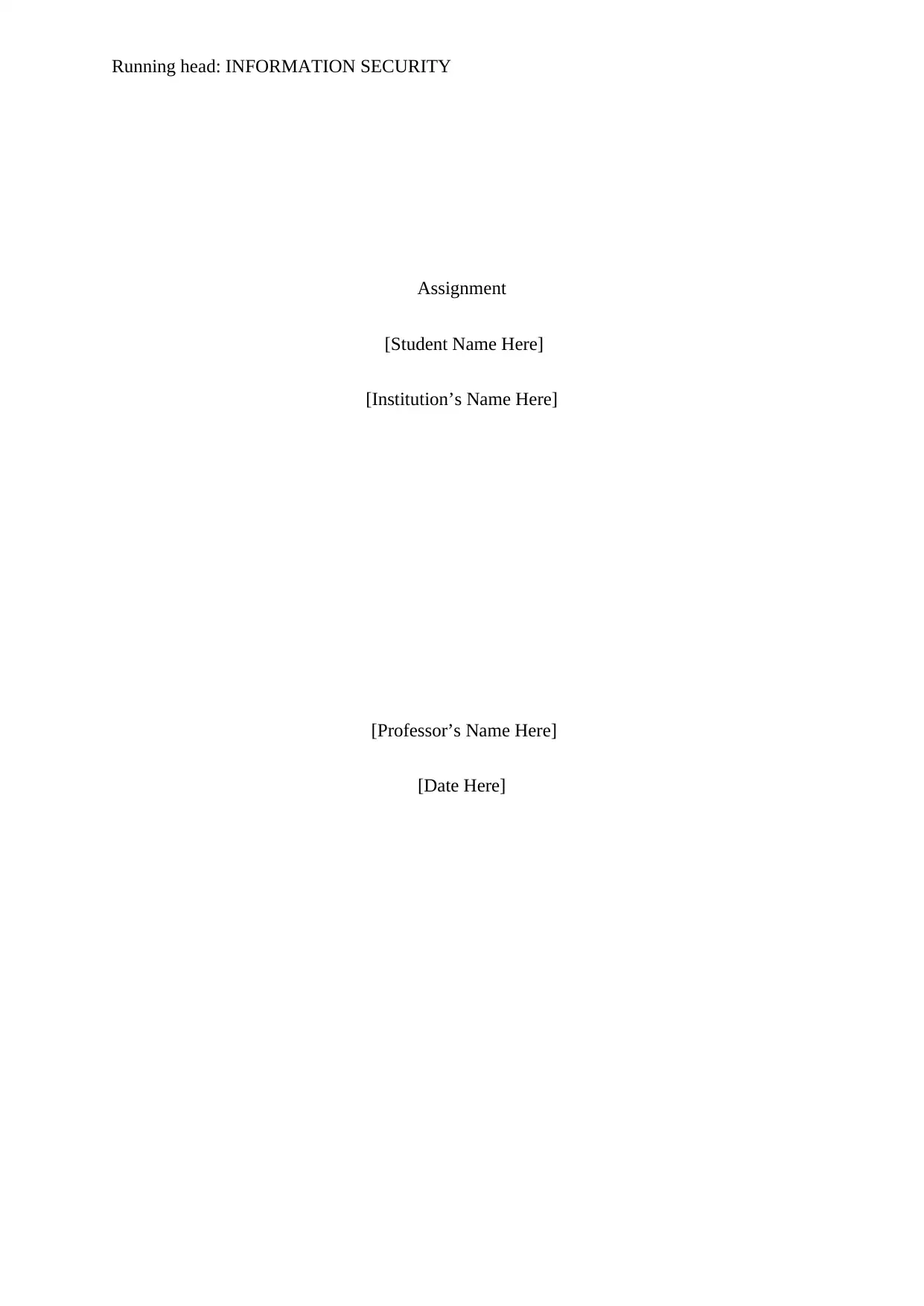
Running head: INFORMATION SECURITY
Assignment
[Student Name Here]
[Institution’s Name Here]
[Professor’s Name Here]
[Date Here]
Assignment
[Student Name Here]
[Institution’s Name Here]
[Professor’s Name Here]
[Date Here]
Paraphrase This Document
Need a fresh take? Get an instant paraphrase of this document with our AI Paraphraser
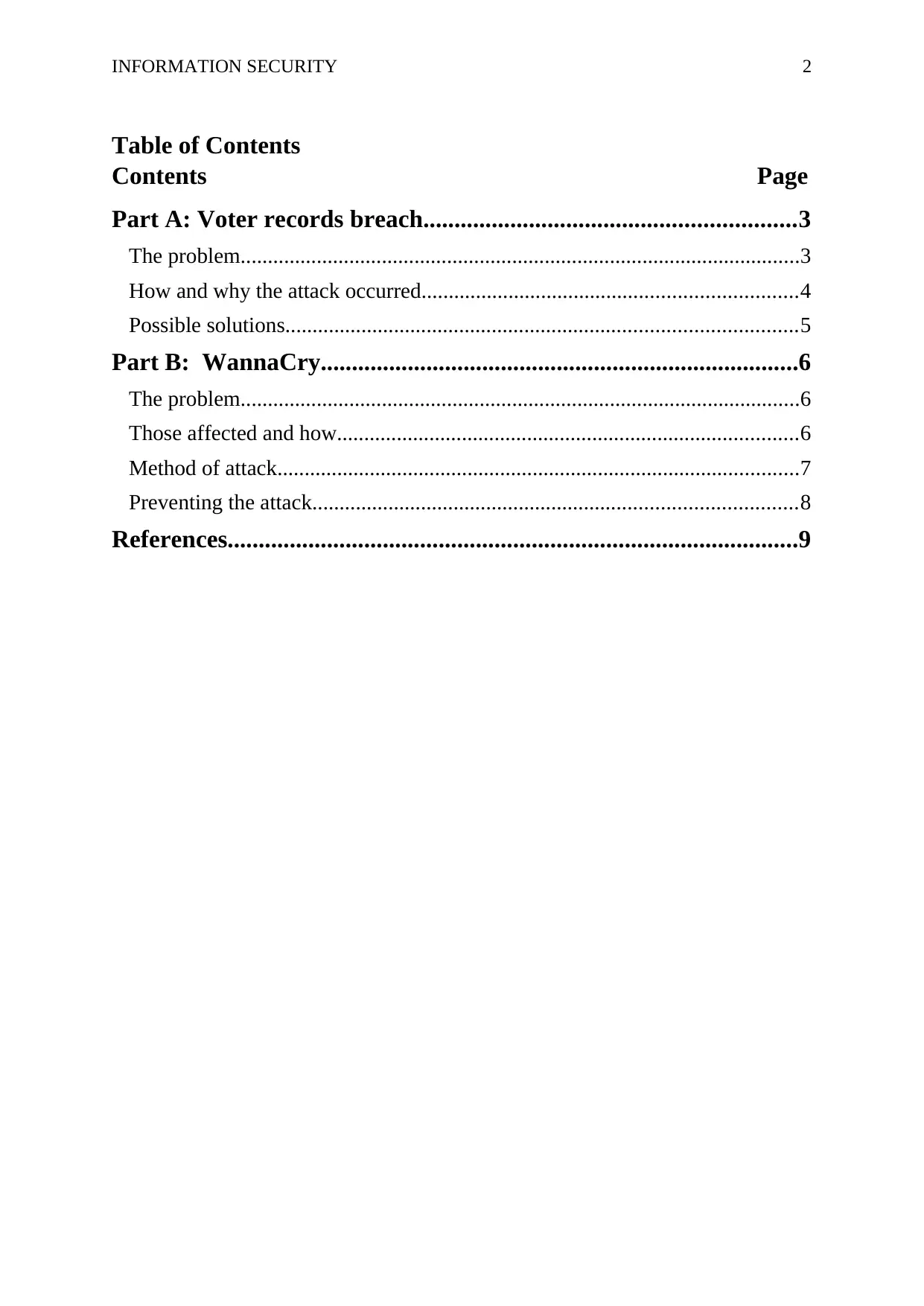
INFORMATION SECURITY 2
Table of Contents
Contents Page
Part A: Voter records breach............................................................3
The problem.......................................................................................................3
How and why the attack occurred.....................................................................4
Possible solutions..............................................................................................5
Part B: WannaCry.............................................................................6
The problem.......................................................................................................6
Those affected and how.....................................................................................6
Method of attack................................................................................................7
Preventing the attack.........................................................................................8
References............................................................................................9
Table of Contents
Contents Page
Part A: Voter records breach............................................................3
The problem.......................................................................................................3
How and why the attack occurred.....................................................................4
Possible solutions..............................................................................................5
Part B: WannaCry.............................................................................6
The problem.......................................................................................................6
Those affected and how.....................................................................................6
Method of attack................................................................................................7
Preventing the attack.........................................................................................8
References............................................................................................9
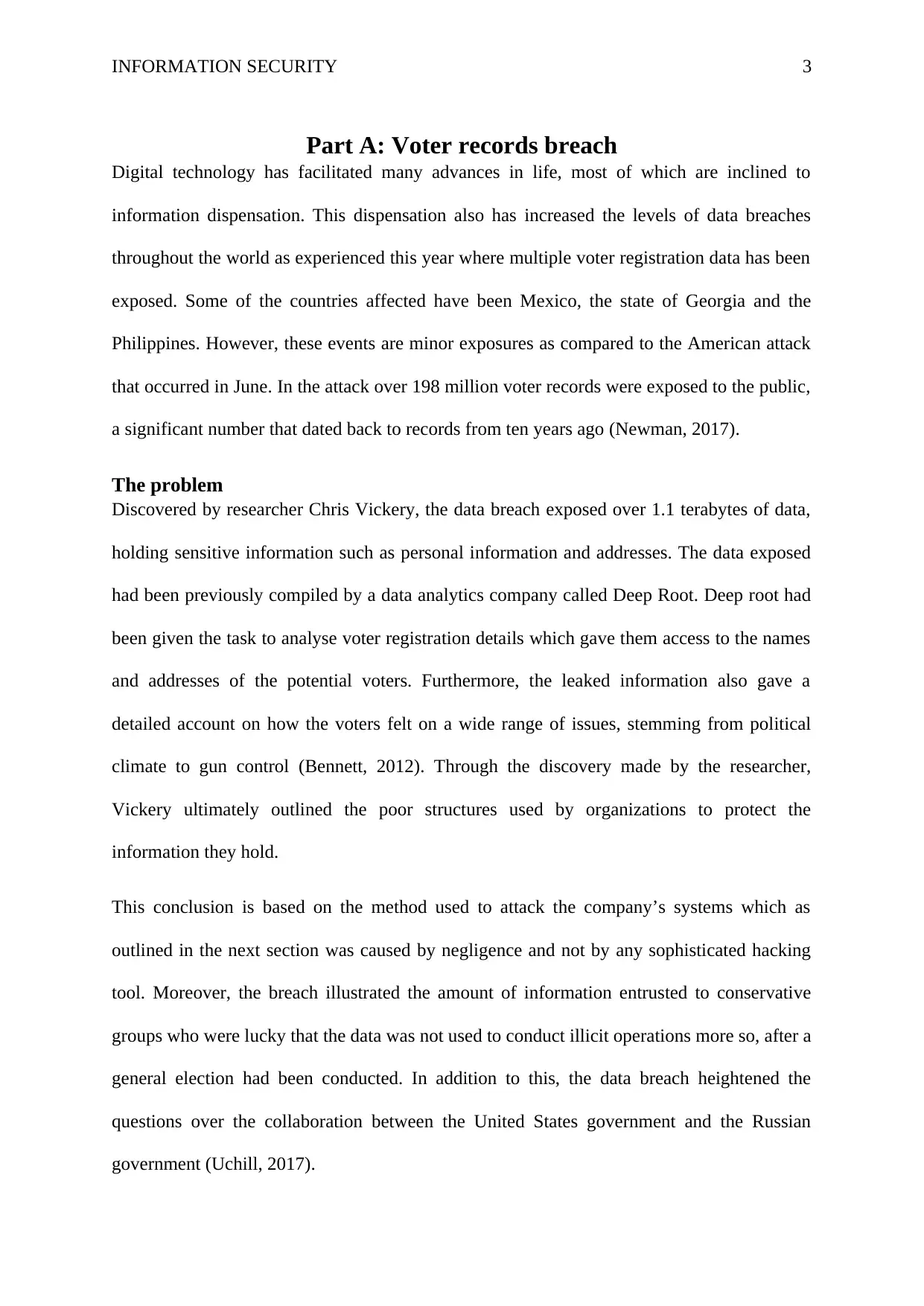
INFORMATION SECURITY 3
Part A: Voter records breach
Digital technology has facilitated many advances in life, most of which are inclined to
information dispensation. This dispensation also has increased the levels of data breaches
throughout the world as experienced this year where multiple voter registration data has been
exposed. Some of the countries affected have been Mexico, the state of Georgia and the
Philippines. However, these events are minor exposures as compared to the American attack
that occurred in June. In the attack over 198 million voter records were exposed to the public,
a significant number that dated back to records from ten years ago (Newman, 2017).
The problem
Discovered by researcher Chris Vickery, the data breach exposed over 1.1 terabytes of data,
holding sensitive information such as personal information and addresses. The data exposed
had been previously compiled by a data analytics company called Deep Root. Deep root had
been given the task to analyse voter registration details which gave them access to the names
and addresses of the potential voters. Furthermore, the leaked information also gave a
detailed account on how the voters felt on a wide range of issues, stemming from political
climate to gun control (Bennett, 2012). Through the discovery made by the researcher,
Vickery ultimately outlined the poor structures used by organizations to protect the
information they hold.
This conclusion is based on the method used to attack the company’s systems which as
outlined in the next section was caused by negligence and not by any sophisticated hacking
tool. Moreover, the breach illustrated the amount of information entrusted to conservative
groups who were lucky that the data was not used to conduct illicit operations more so, after a
general election had been conducted. In addition to this, the data breach heightened the
questions over the collaboration between the United States government and the Russian
government (Uchill, 2017).
Part A: Voter records breach
Digital technology has facilitated many advances in life, most of which are inclined to
information dispensation. This dispensation also has increased the levels of data breaches
throughout the world as experienced this year where multiple voter registration data has been
exposed. Some of the countries affected have been Mexico, the state of Georgia and the
Philippines. However, these events are minor exposures as compared to the American attack
that occurred in June. In the attack over 198 million voter records were exposed to the public,
a significant number that dated back to records from ten years ago (Newman, 2017).
The problem
Discovered by researcher Chris Vickery, the data breach exposed over 1.1 terabytes of data,
holding sensitive information such as personal information and addresses. The data exposed
had been previously compiled by a data analytics company called Deep Root. Deep root had
been given the task to analyse voter registration details which gave them access to the names
and addresses of the potential voters. Furthermore, the leaked information also gave a
detailed account on how the voters felt on a wide range of issues, stemming from political
climate to gun control (Bennett, 2012). Through the discovery made by the researcher,
Vickery ultimately outlined the poor structures used by organizations to protect the
information they hold.
This conclusion is based on the method used to attack the company’s systems which as
outlined in the next section was caused by negligence and not by any sophisticated hacking
tool. Moreover, the breach illustrated the amount of information entrusted to conservative
groups who were lucky that the data was not used to conduct illicit operations more so, after a
general election had been conducted. In addition to this, the data breach heightened the
questions over the collaboration between the United States government and the Russian
government (Uchill, 2017).
⊘ This is a preview!⊘
Do you want full access?
Subscribe today to unlock all pages.

Trusted by 1+ million students worldwide
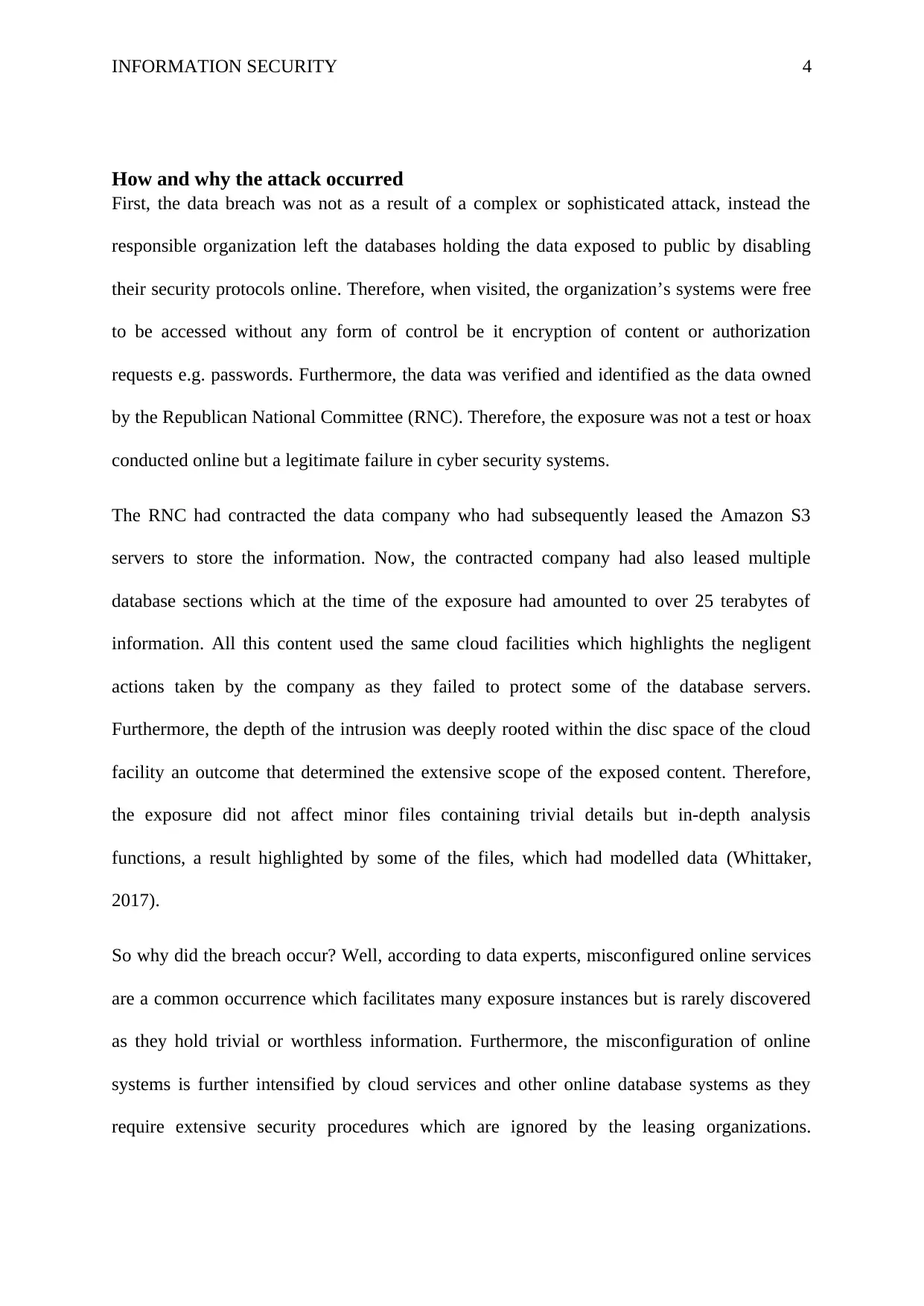
INFORMATION SECURITY 4
How and why the attack occurred
First, the data breach was not as a result of a complex or sophisticated attack, instead the
responsible organization left the databases holding the data exposed to public by disabling
their security protocols online. Therefore, when visited, the organization’s systems were free
to be accessed without any form of control be it encryption of content or authorization
requests e.g. passwords. Furthermore, the data was verified and identified as the data owned
by the Republican National Committee (RNC). Therefore, the exposure was not a test or hoax
conducted online but a legitimate failure in cyber security systems.
The RNC had contracted the data company who had subsequently leased the Amazon S3
servers to store the information. Now, the contracted company had also leased multiple
database sections which at the time of the exposure had amounted to over 25 terabytes of
information. All this content used the same cloud facilities which highlights the negligent
actions taken by the company as they failed to protect some of the database servers.
Furthermore, the depth of the intrusion was deeply rooted within the disc space of the cloud
facility an outcome that determined the extensive scope of the exposed content. Therefore,
the exposure did not affect minor files containing trivial details but in-depth analysis
functions, a result highlighted by some of the files, which had modelled data (Whittaker,
2017).
So why did the breach occur? Well, according to data experts, misconfigured online services
are a common occurrence which facilitates many exposure instances but is rarely discovered
as they hold trivial or worthless information. Furthermore, the misconfiguration of online
systems is further intensified by cloud services and other online database systems as they
require extensive security procedures which are ignored by the leasing organizations.
How and why the attack occurred
First, the data breach was not as a result of a complex or sophisticated attack, instead the
responsible organization left the databases holding the data exposed to public by disabling
their security protocols online. Therefore, when visited, the organization’s systems were free
to be accessed without any form of control be it encryption of content or authorization
requests e.g. passwords. Furthermore, the data was verified and identified as the data owned
by the Republican National Committee (RNC). Therefore, the exposure was not a test or hoax
conducted online but a legitimate failure in cyber security systems.
The RNC had contracted the data company who had subsequently leased the Amazon S3
servers to store the information. Now, the contracted company had also leased multiple
database sections which at the time of the exposure had amounted to over 25 terabytes of
information. All this content used the same cloud facilities which highlights the negligent
actions taken by the company as they failed to protect some of the database servers.
Furthermore, the depth of the intrusion was deeply rooted within the disc space of the cloud
facility an outcome that determined the extensive scope of the exposed content. Therefore,
the exposure did not affect minor files containing trivial details but in-depth analysis
functions, a result highlighted by some of the files, which had modelled data (Whittaker,
2017).
So why did the breach occur? Well, according to data experts, misconfigured online services
are a common occurrence which facilitates many exposure instances but is rarely discovered
as they hold trivial or worthless information. Furthermore, the misconfiguration of online
systems is further intensified by cloud services and other online database systems as they
require extensive security procedures which are ignored by the leasing organizations.
Paraphrase This Document
Need a fresh take? Get an instant paraphrase of this document with our AI Paraphraser
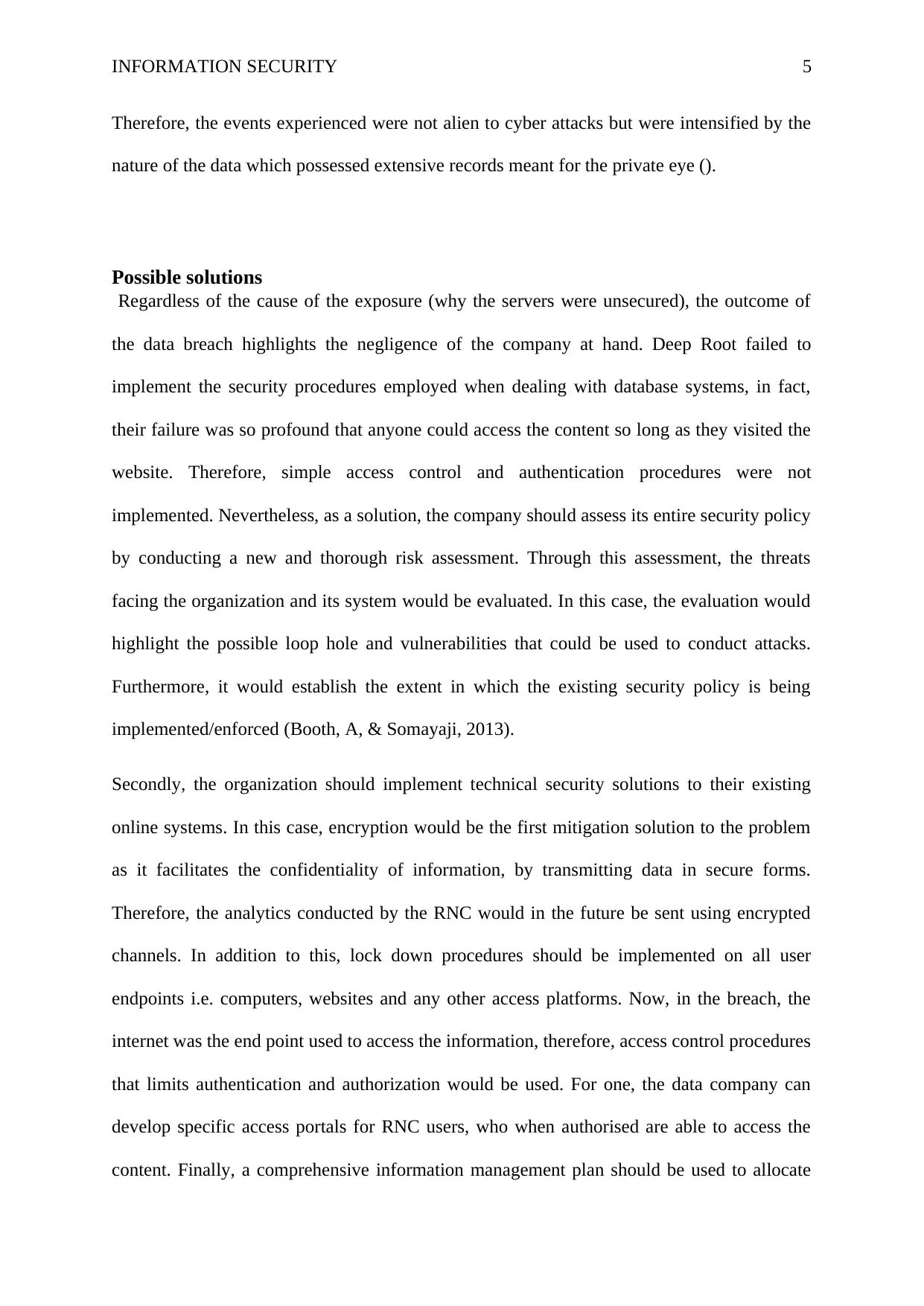
INFORMATION SECURITY 5
Therefore, the events experienced were not alien to cyber attacks but were intensified by the
nature of the data which possessed extensive records meant for the private eye ().
Possible solutions
Regardless of the cause of the exposure (why the servers were unsecured), the outcome of
the data breach highlights the negligence of the company at hand. Deep Root failed to
implement the security procedures employed when dealing with database systems, in fact,
their failure was so profound that anyone could access the content so long as they visited the
website. Therefore, simple access control and authentication procedures were not
implemented. Nevertheless, as a solution, the company should assess its entire security policy
by conducting a new and thorough risk assessment. Through this assessment, the threats
facing the organization and its system would be evaluated. In this case, the evaluation would
highlight the possible loop hole and vulnerabilities that could be used to conduct attacks.
Furthermore, it would establish the extent in which the existing security policy is being
implemented/enforced (Booth, A, & Somayaji, 2013).
Secondly, the organization should implement technical security solutions to their existing
online systems. In this case, encryption would be the first mitigation solution to the problem
as it facilitates the confidentiality of information, by transmitting data in secure forms.
Therefore, the analytics conducted by the RNC would in the future be sent using encrypted
channels. In addition to this, lock down procedures should be implemented on all user
endpoints i.e. computers, websites and any other access platforms. Now, in the breach, the
internet was the end point used to access the information, therefore, access control procedures
that limits authentication and authorization would be used. For one, the data company can
develop specific access portals for RNC users, who when authorised are able to access the
content. Finally, a comprehensive information management plan should be used to allocate
Therefore, the events experienced were not alien to cyber attacks but were intensified by the
nature of the data which possessed extensive records meant for the private eye ().
Possible solutions
Regardless of the cause of the exposure (why the servers were unsecured), the outcome of
the data breach highlights the negligence of the company at hand. Deep Root failed to
implement the security procedures employed when dealing with database systems, in fact,
their failure was so profound that anyone could access the content so long as they visited the
website. Therefore, simple access control and authentication procedures were not
implemented. Nevertheless, as a solution, the company should assess its entire security policy
by conducting a new and thorough risk assessment. Through this assessment, the threats
facing the organization and its system would be evaluated. In this case, the evaluation would
highlight the possible loop hole and vulnerabilities that could be used to conduct attacks.
Furthermore, it would establish the extent in which the existing security policy is being
implemented/enforced (Booth, A, & Somayaji, 2013).
Secondly, the organization should implement technical security solutions to their existing
online systems. In this case, encryption would be the first mitigation solution to the problem
as it facilitates the confidentiality of information, by transmitting data in secure forms.
Therefore, the analytics conducted by the RNC would in the future be sent using encrypted
channels. In addition to this, lock down procedures should be implemented on all user
endpoints i.e. computers, websites and any other access platforms. Now, in the breach, the
internet was the end point used to access the information, therefore, access control procedures
that limits authentication and authorization would be used. For one, the data company can
develop specific access portals for RNC users, who when authorised are able to access the
content. Finally, a comprehensive information management plan should be used to allocate
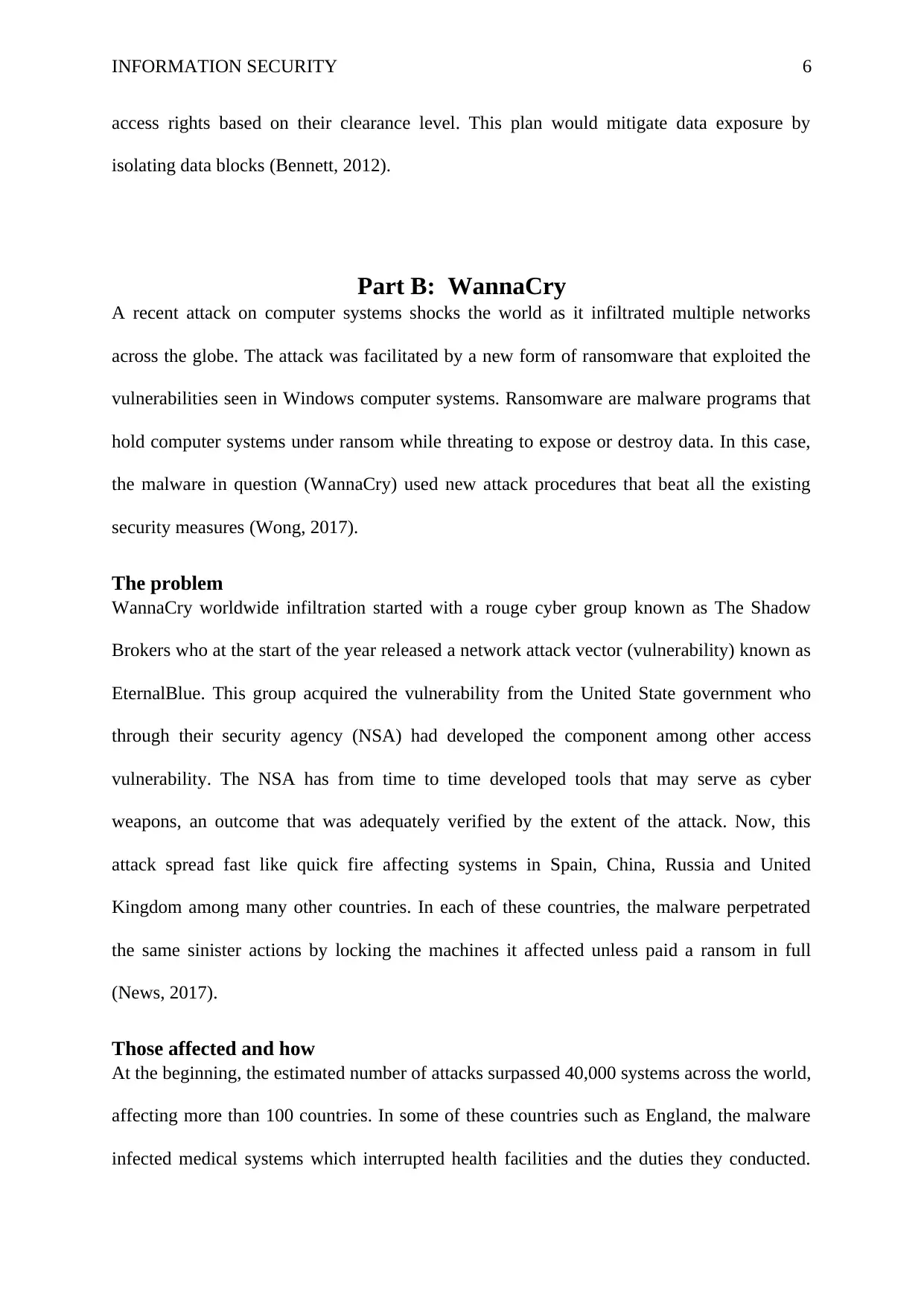
INFORMATION SECURITY 6
access rights based on their clearance level. This plan would mitigate data exposure by
isolating data blocks (Bennett, 2012).
Part B: WannaCry
A recent attack on computer systems shocks the world as it infiltrated multiple networks
across the globe. The attack was facilitated by a new form of ransomware that exploited the
vulnerabilities seen in Windows computer systems. Ransomware are malware programs that
hold computer systems under ransom while threating to expose or destroy data. In this case,
the malware in question (WannaCry) used new attack procedures that beat all the existing
security measures (Wong, 2017).
The problem
WannaCry worldwide infiltration started with a rouge cyber group known as The Shadow
Brokers who at the start of the year released a network attack vector (vulnerability) known as
EternalBlue. This group acquired the vulnerability from the United State government who
through their security agency (NSA) had developed the component among other access
vulnerability. The NSA has from time to time developed tools that may serve as cyber
weapons, an outcome that was adequately verified by the extent of the attack. Now, this
attack spread fast like quick fire affecting systems in Spain, China, Russia and United
Kingdom among many other countries. In each of these countries, the malware perpetrated
the same sinister actions by locking the machines it affected unless paid a ransom in full
(News, 2017).
Those affected and how
At the beginning, the estimated number of attacks surpassed 40,000 systems across the world,
affecting more than 100 countries. In some of these countries such as England, the malware
infected medical systems which interrupted health facilities and the duties they conducted.
access rights based on their clearance level. This plan would mitigate data exposure by
isolating data blocks (Bennett, 2012).
Part B: WannaCry
A recent attack on computer systems shocks the world as it infiltrated multiple networks
across the globe. The attack was facilitated by a new form of ransomware that exploited the
vulnerabilities seen in Windows computer systems. Ransomware are malware programs that
hold computer systems under ransom while threating to expose or destroy data. In this case,
the malware in question (WannaCry) used new attack procedures that beat all the existing
security measures (Wong, 2017).
The problem
WannaCry worldwide infiltration started with a rouge cyber group known as The Shadow
Brokers who at the start of the year released a network attack vector (vulnerability) known as
EternalBlue. This group acquired the vulnerability from the United State government who
through their security agency (NSA) had developed the component among other access
vulnerability. The NSA has from time to time developed tools that may serve as cyber
weapons, an outcome that was adequately verified by the extent of the attack. Now, this
attack spread fast like quick fire affecting systems in Spain, China, Russia and United
Kingdom among many other countries. In each of these countries, the malware perpetrated
the same sinister actions by locking the machines it affected unless paid a ransom in full
(News, 2017).
Those affected and how
At the beginning, the estimated number of attacks surpassed 40,000 systems across the world,
affecting more than 100 countries. In some of these countries such as England, the malware
infected medical systems which interrupted health facilities and the duties they conducted.
⊘ This is a preview!⊘
Do you want full access?
Subscribe today to unlock all pages.

Trusted by 1+ million students worldwide
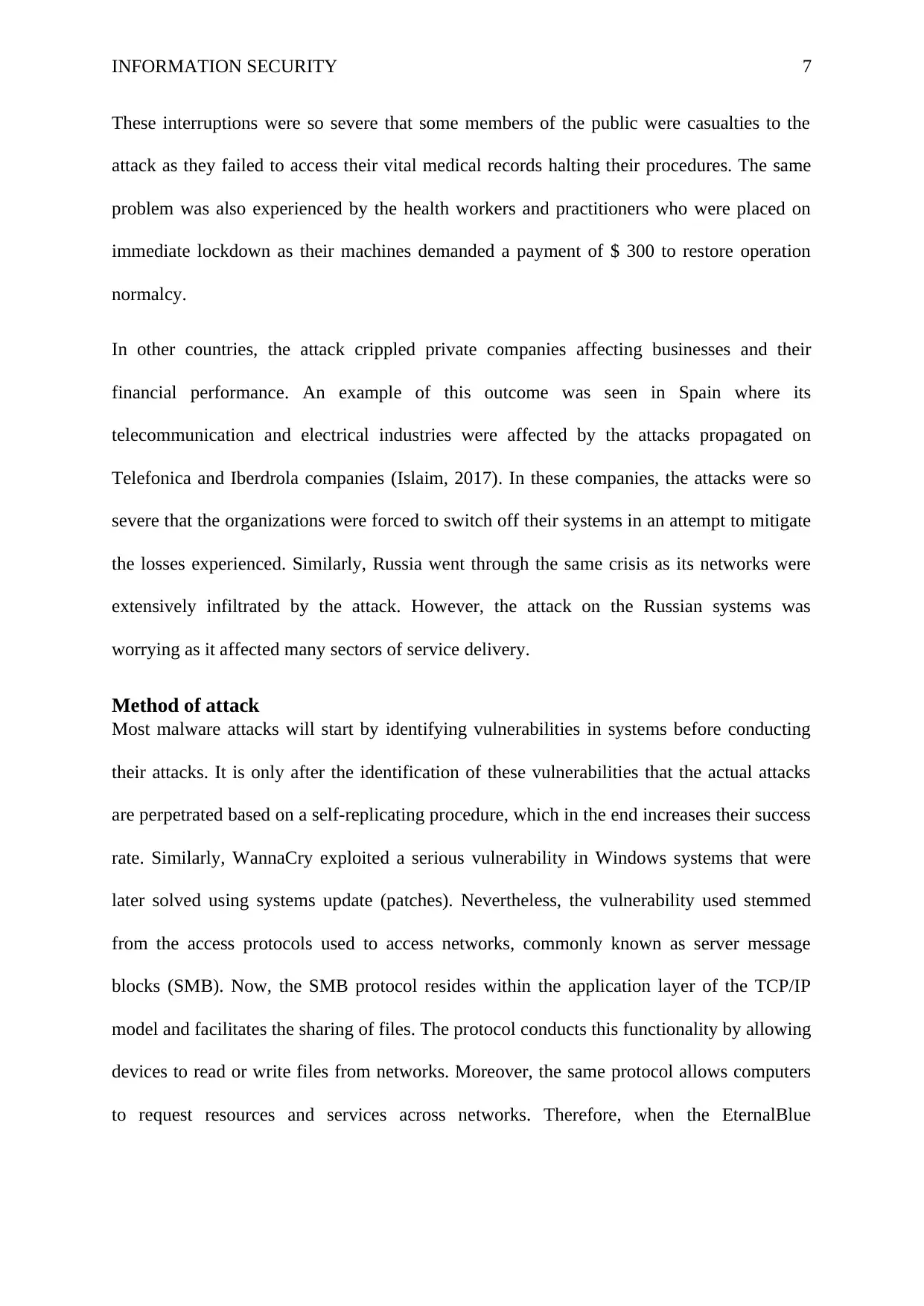
INFORMATION SECURITY 7
These interruptions were so severe that some members of the public were casualties to the
attack as they failed to access their vital medical records halting their procedures. The same
problem was also experienced by the health workers and practitioners who were placed on
immediate lockdown as their machines demanded a payment of $ 300 to restore operation
normalcy.
In other countries, the attack crippled private companies affecting businesses and their
financial performance. An example of this outcome was seen in Spain where its
telecommunication and electrical industries were affected by the attacks propagated on
Telefonica and Iberdrola companies (Islaim, 2017). In these companies, the attacks were so
severe that the organizations were forced to switch off their systems in an attempt to mitigate
the losses experienced. Similarly, Russia went through the same crisis as its networks were
extensively infiltrated by the attack. However, the attack on the Russian systems was
worrying as it affected many sectors of service delivery.
Method of attack
Most malware attacks will start by identifying vulnerabilities in systems before conducting
their attacks. It is only after the identification of these vulnerabilities that the actual attacks
are perpetrated based on a self-replicating procedure, which in the end increases their success
rate. Similarly, WannaCry exploited a serious vulnerability in Windows systems that were
later solved using systems update (patches). Nevertheless, the vulnerability used stemmed
from the access protocols used to access networks, commonly known as server message
blocks (SMB). Now, the SMB protocol resides within the application layer of the TCP/IP
model and facilitates the sharing of files. The protocol conducts this functionality by allowing
devices to read or write files from networks. Moreover, the same protocol allows computers
to request resources and services across networks. Therefore, when the EternalBlue
These interruptions were so severe that some members of the public were casualties to the
attack as they failed to access their vital medical records halting their procedures. The same
problem was also experienced by the health workers and practitioners who were placed on
immediate lockdown as their machines demanded a payment of $ 300 to restore operation
normalcy.
In other countries, the attack crippled private companies affecting businesses and their
financial performance. An example of this outcome was seen in Spain where its
telecommunication and electrical industries were affected by the attacks propagated on
Telefonica and Iberdrola companies (Islaim, 2017). In these companies, the attacks were so
severe that the organizations were forced to switch off their systems in an attempt to mitigate
the losses experienced. Similarly, Russia went through the same crisis as its networks were
extensively infiltrated by the attack. However, the attack on the Russian systems was
worrying as it affected many sectors of service delivery.
Method of attack
Most malware attacks will start by identifying vulnerabilities in systems before conducting
their attacks. It is only after the identification of these vulnerabilities that the actual attacks
are perpetrated based on a self-replicating procedure, which in the end increases their success
rate. Similarly, WannaCry exploited a serious vulnerability in Windows systems that were
later solved using systems update (patches). Nevertheless, the vulnerability used stemmed
from the access protocols used to access networks, commonly known as server message
blocks (SMB). Now, the SMB protocol resides within the application layer of the TCP/IP
model and facilitates the sharing of files. The protocol conducts this functionality by allowing
devices to read or write files from networks. Moreover, the same protocol allows computers
to request resources and services across networks. Therefore, when the EternalBlue
Paraphrase This Document
Need a fresh take? Get an instant paraphrase of this document with our AI Paraphraser
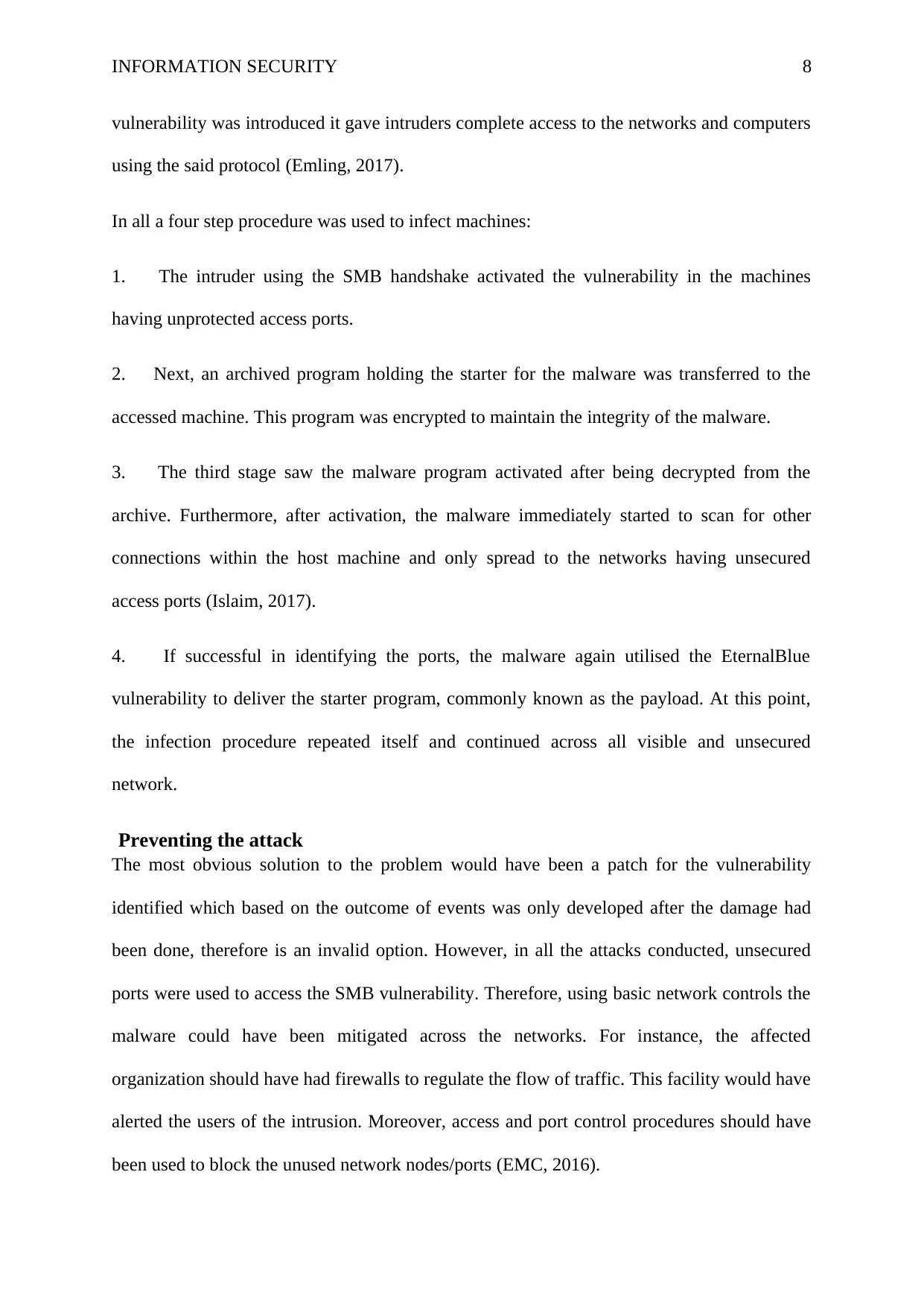
INFORMATION SECURITY 8
vulnerability was introduced it gave intruders complete access to the networks and computers
using the said protocol (Emling, 2017).
In all a four step procedure was used to infect machines:
1. The intruder using the SMB handshake activated the vulnerability in the machines
having unprotected access ports.
2. Next, an archived program holding the starter for the malware was transferred to the
accessed machine. This program was encrypted to maintain the integrity of the malware.
3. The third stage saw the malware program activated after being decrypted from the
archive. Furthermore, after activation, the malware immediately started to scan for other
connections within the host machine and only spread to the networks having unsecured
access ports (Islaim, 2017).
4. If successful in identifying the ports, the malware again utilised the EternalBlue
vulnerability to deliver the starter program, commonly known as the payload. At this point,
the infection procedure repeated itself and continued across all visible and unsecured
network.
Preventing the attack
The most obvious solution to the problem would have been a patch for the vulnerability
identified which based on the outcome of events was only developed after the damage had
been done, therefore is an invalid option. However, in all the attacks conducted, unsecured
ports were used to access the SMB vulnerability. Therefore, using basic network controls the
malware could have been mitigated across the networks. For instance, the affected
organization should have had firewalls to regulate the flow of traffic. This facility would have
alerted the users of the intrusion. Moreover, access and port control procedures should have
been used to block the unused network nodes/ports (EMC, 2016).
vulnerability was introduced it gave intruders complete access to the networks and computers
using the said protocol (Emling, 2017).
In all a four step procedure was used to infect machines:
1. The intruder using the SMB handshake activated the vulnerability in the machines
having unprotected access ports.
2. Next, an archived program holding the starter for the malware was transferred to the
accessed machine. This program was encrypted to maintain the integrity of the malware.
3. The third stage saw the malware program activated after being decrypted from the
archive. Furthermore, after activation, the malware immediately started to scan for other
connections within the host machine and only spread to the networks having unsecured
access ports (Islaim, 2017).
4. If successful in identifying the ports, the malware again utilised the EternalBlue
vulnerability to deliver the starter program, commonly known as the payload. At this point,
the infection procedure repeated itself and continued across all visible and unsecured
network.
Preventing the attack
The most obvious solution to the problem would have been a patch for the vulnerability
identified which based on the outcome of events was only developed after the damage had
been done, therefore is an invalid option. However, in all the attacks conducted, unsecured
ports were used to access the SMB vulnerability. Therefore, using basic network controls the
malware could have been mitigated across the networks. For instance, the affected
organization should have had firewalls to regulate the flow of traffic. This facility would have
alerted the users of the intrusion. Moreover, access and port control procedures should have
been used to block the unused network nodes/ports (EMC, 2016).
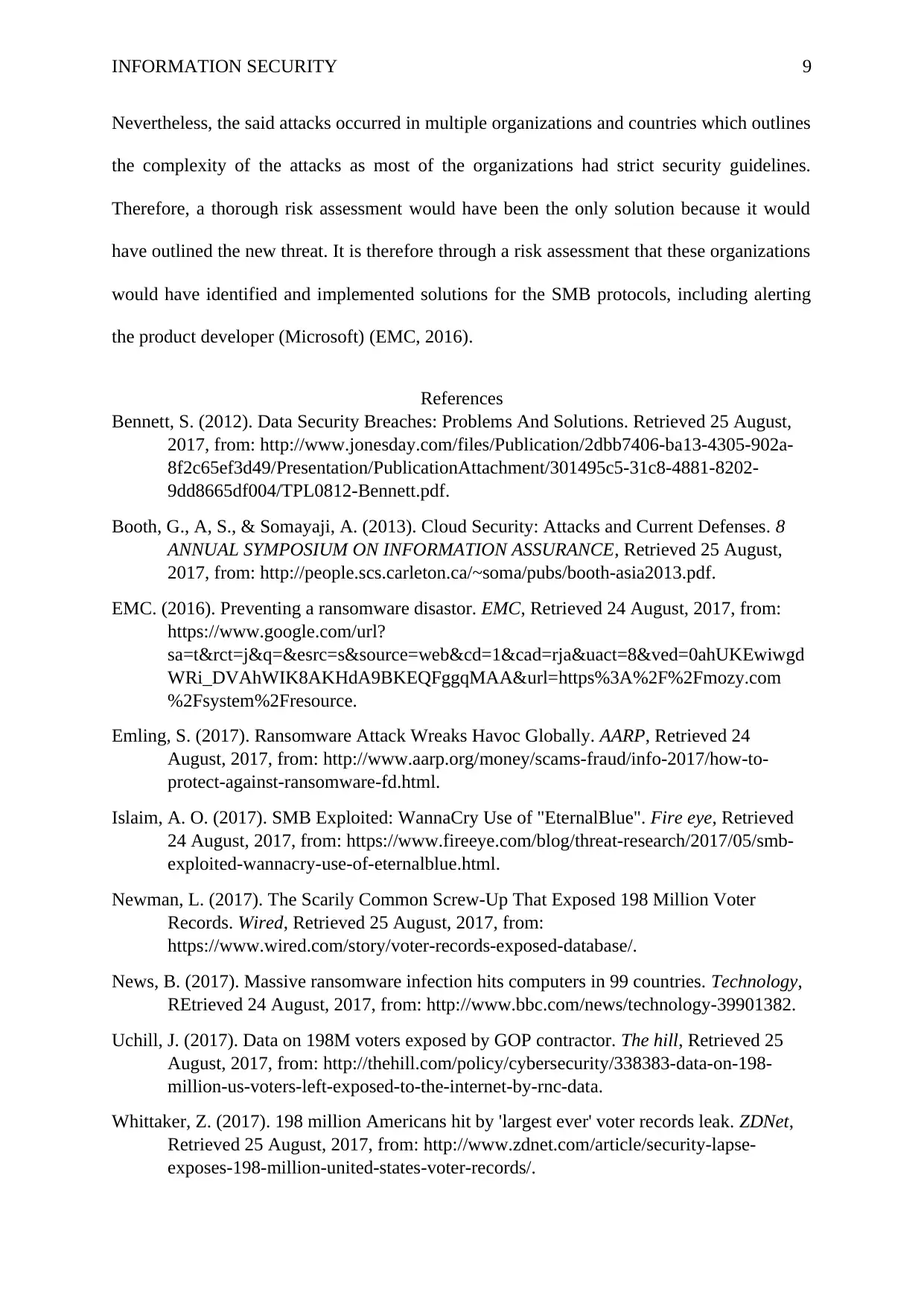
INFORMATION SECURITY 9
Nevertheless, the said attacks occurred in multiple organizations and countries which outlines
the complexity of the attacks as most of the organizations had strict security guidelines.
Therefore, a thorough risk assessment would have been the only solution because it would
have outlined the new threat. It is therefore through a risk assessment that these organizations
would have identified and implemented solutions for the SMB protocols, including alerting
the product developer (Microsoft) (EMC, 2016).
References
Bennett, S. (2012). Data Security Breaches: Problems And Solutions. Retrieved 25 August,
2017, from: http://www.jonesday.com/files/Publication/2dbb7406-ba13-4305-902a-
8f2c65ef3d49/Presentation/PublicationAttachment/301495c5-31c8-4881-8202-
9dd8665df004/TPL0812-Bennett.pdf.
Booth, G., A, S., & Somayaji, A. (2013). Cloud Security: Attacks and Current Defenses. 8
ANNUAL SYMPOSIUM ON INFORMATION ASSURANCE, Retrieved 25 August,
2017, from: http://people.scs.carleton.ca/~soma/pubs/booth-asia2013.pdf.
EMC. (2016). Preventing a ransomware disastor. EMC, Retrieved 24 August, 2017, from:
https://www.google.com/url?
sa=t&rct=j&q=&esrc=s&source=web&cd=1&cad=rja&uact=8&ved=0ahUKEwiwgd
WRi_DVAhWIK8AKHdA9BKEQFggqMAA&url=https%3A%2F%2Fmozy.com
%2Fsystem%2Fresource.
Emling, S. (2017). Ransomware Attack Wreaks Havoc Globally. AARP, Retrieved 24
August, 2017, from: http://www.aarp.org/money/scams-fraud/info-2017/how-to-
protect-against-ransomware-fd.html.
Islaim, A. O. (2017). SMB Exploited: WannaCry Use of "EternalBlue". Fire eye, Retrieved
24 August, 2017, from: https://www.fireeye.com/blog/threat-research/2017/05/smb-
exploited-wannacry-use-of-eternalblue.html.
Newman, L. (2017). The Scarily Common Screw-Up That Exposed 198 Million Voter
Records. Wired, Retrieved 25 August, 2017, from:
https://www.wired.com/story/voter-records-exposed-database/.
News, B. (2017). Massive ransomware infection hits computers in 99 countries. Technology,
REtrieved 24 August, 2017, from: http://www.bbc.com/news/technology-39901382.
Uchill, J. (2017). Data on 198M voters exposed by GOP contractor. The hill, Retrieved 25
August, 2017, from: http://thehill.com/policy/cybersecurity/338383-data-on-198-
million-us-voters-left-exposed-to-the-internet-by-rnc-data.
Whittaker, Z. (2017). 198 million Americans hit by 'largest ever' voter records leak. ZDNet,
Retrieved 25 August, 2017, from: http://www.zdnet.com/article/security-lapse-
exposes-198-million-united-states-voter-records/.
Nevertheless, the said attacks occurred in multiple organizations and countries which outlines
the complexity of the attacks as most of the organizations had strict security guidelines.
Therefore, a thorough risk assessment would have been the only solution because it would
have outlined the new threat. It is therefore through a risk assessment that these organizations
would have identified and implemented solutions for the SMB protocols, including alerting
the product developer (Microsoft) (EMC, 2016).
References
Bennett, S. (2012). Data Security Breaches: Problems And Solutions. Retrieved 25 August,
2017, from: http://www.jonesday.com/files/Publication/2dbb7406-ba13-4305-902a-
8f2c65ef3d49/Presentation/PublicationAttachment/301495c5-31c8-4881-8202-
9dd8665df004/TPL0812-Bennett.pdf.
Booth, G., A, S., & Somayaji, A. (2013). Cloud Security: Attacks and Current Defenses. 8
ANNUAL SYMPOSIUM ON INFORMATION ASSURANCE, Retrieved 25 August,
2017, from: http://people.scs.carleton.ca/~soma/pubs/booth-asia2013.pdf.
EMC. (2016). Preventing a ransomware disastor. EMC, Retrieved 24 August, 2017, from:
https://www.google.com/url?
sa=t&rct=j&q=&esrc=s&source=web&cd=1&cad=rja&uact=8&ved=0ahUKEwiwgd
WRi_DVAhWIK8AKHdA9BKEQFggqMAA&url=https%3A%2F%2Fmozy.com
%2Fsystem%2Fresource.
Emling, S. (2017). Ransomware Attack Wreaks Havoc Globally. AARP, Retrieved 24
August, 2017, from: http://www.aarp.org/money/scams-fraud/info-2017/how-to-
protect-against-ransomware-fd.html.
Islaim, A. O. (2017). SMB Exploited: WannaCry Use of "EternalBlue". Fire eye, Retrieved
24 August, 2017, from: https://www.fireeye.com/blog/threat-research/2017/05/smb-
exploited-wannacry-use-of-eternalblue.html.
Newman, L. (2017). The Scarily Common Screw-Up That Exposed 198 Million Voter
Records. Wired, Retrieved 25 August, 2017, from:
https://www.wired.com/story/voter-records-exposed-database/.
News, B. (2017). Massive ransomware infection hits computers in 99 countries. Technology,
REtrieved 24 August, 2017, from: http://www.bbc.com/news/technology-39901382.
Uchill, J. (2017). Data on 198M voters exposed by GOP contractor. The hill, Retrieved 25
August, 2017, from: http://thehill.com/policy/cybersecurity/338383-data-on-198-
million-us-voters-left-exposed-to-the-internet-by-rnc-data.
Whittaker, Z. (2017). 198 million Americans hit by 'largest ever' voter records leak. ZDNet,
Retrieved 25 August, 2017, from: http://www.zdnet.com/article/security-lapse-
exposes-198-million-united-states-voter-records/.
⊘ This is a preview!⊘
Do you want full access?
Subscribe today to unlock all pages.

Trusted by 1+ million students worldwide

INFORMATION SECURITY 10
Wong, J. &. (2017). Massive ransomware cyber-attack hits nearly 100 countries around the
world . Cybercrime, Retrieved 24 August, 2017, from:
https://www.theguardian.com/technology/2017/may/12/global-cyber-attack-
ransomware-nsa-uk-nhs.
Wong, J. &. (2017). Massive ransomware cyber-attack hits nearly 100 countries around the
world . Cybercrime, Retrieved 24 August, 2017, from:
https://www.theguardian.com/technology/2017/may/12/global-cyber-attack-
ransomware-nsa-uk-nhs.
1 out of 10
Related Documents
Your All-in-One AI-Powered Toolkit for Academic Success.
+13062052269
info@desklib.com
Available 24*7 on WhatsApp / Email
![[object Object]](/_next/static/media/star-bottom.7253800d.svg)
Unlock your academic potential
Copyright © 2020–2025 A2Z Services. All Rights Reserved. Developed and managed by ZUCOL.





